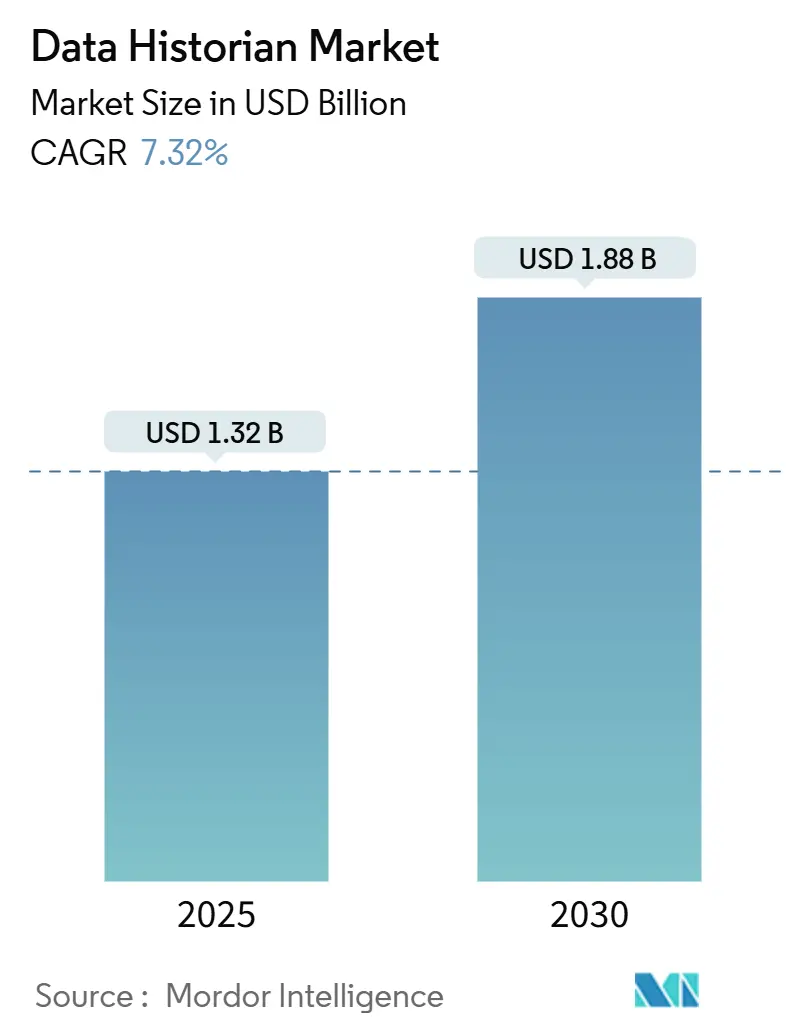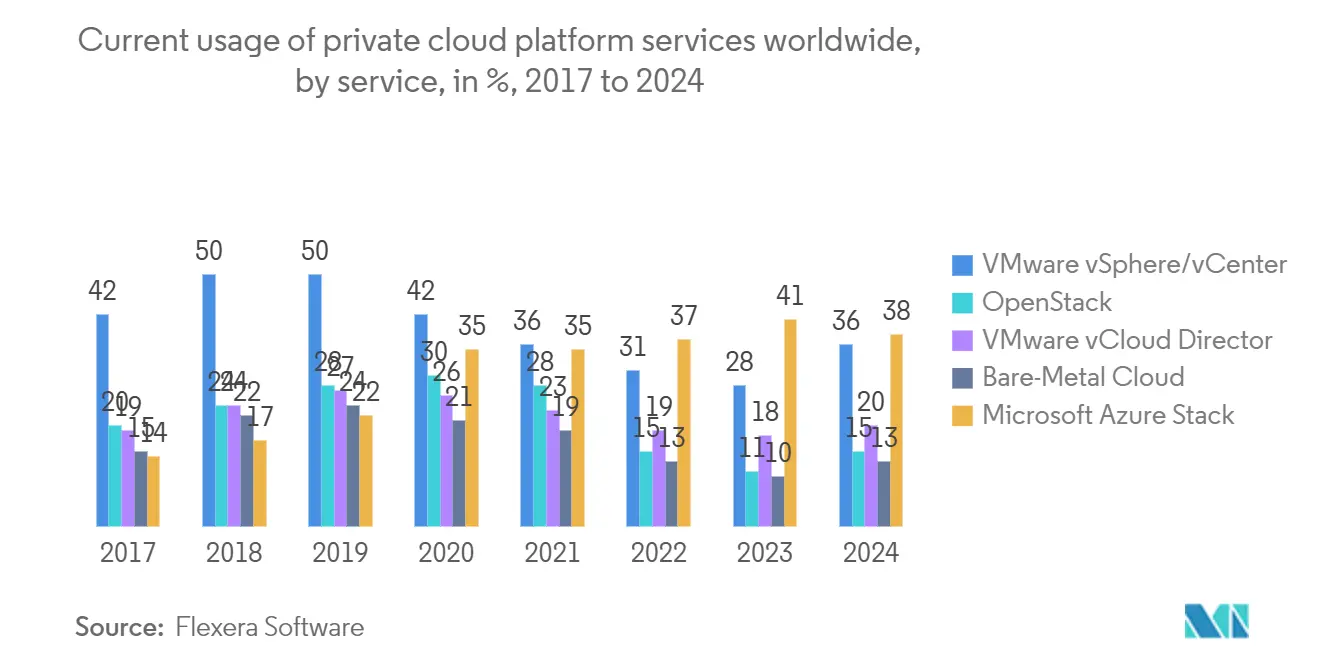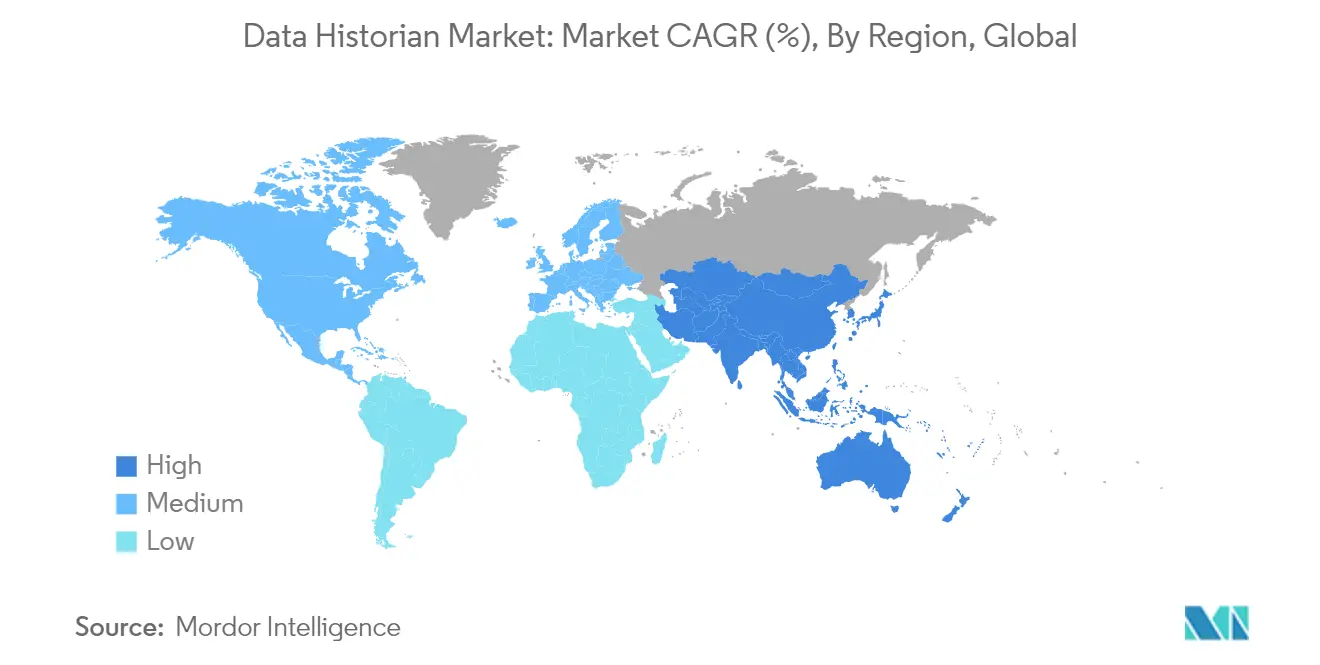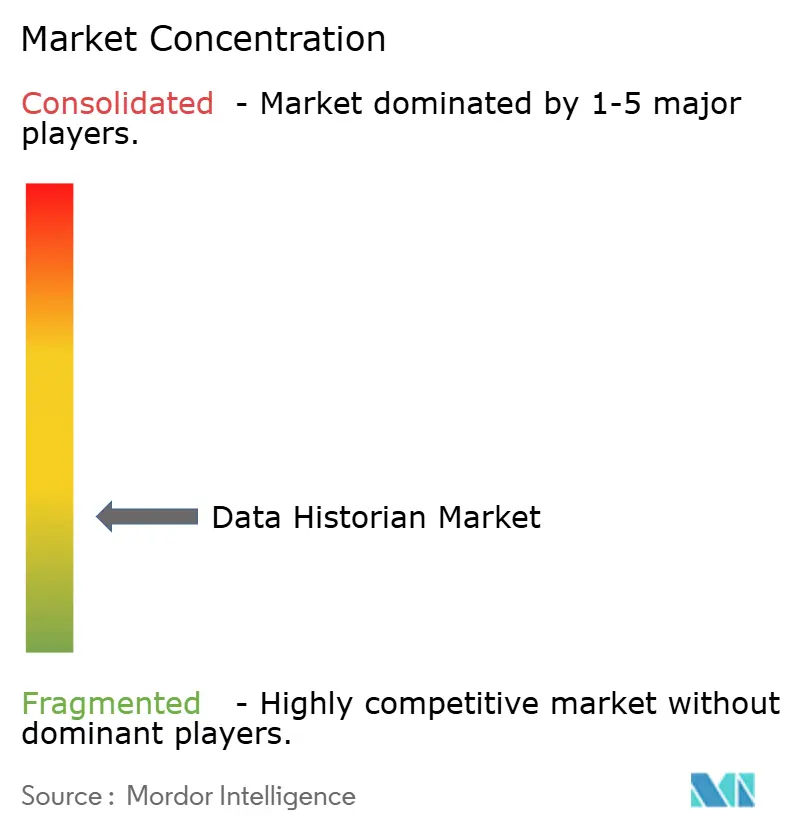
Data Historian Market Analysis
The Data Historian Market size is estimated at USD 1.32 billion in 2025, and is expected to reach USD 1.88 billion by 2030, at a CAGR of 7.32% during the forecast period (2025-2030).
- As IoT devices, cloud applications, and social media churn out ever-increasing volumes of data, the demand for data historian surges. Many industries, especially financial services, contend with regulations mandating the storage of historical data. Data historians address compliance needs and allow organizations to extract valuable insights from their data. This dual advantage drives heightened demand across these sectors.
- As data centers expand, they fuel the growth of data historians, providing the crucial infrastructure for storing, processing, and analyzing massive volumes of data. With advanced processing capabilities like high-performance computing and data analytics tools, data centers enable organizations to unearth valuable insights and trends. Consequently, as data centers become increasingly prevalent in industrial control systems (ICS) and data historians, investments in these centers are surging, propelling market growth.
- As industries like oil & gas, manufacturing, and energy increasingly seek real-time data analytics, predictive maintenance, and operational efficiency, the data historian market is witnessing robust growth. This surge is primarily driven by the adoption of the Industrial Internet of Things (IIoT) and Industry 4.0, which produce vast amounts of time-series data. Furthermore, as regulatory compliance becomes paramount and cloud-based historian solutions advance, scalability and accessibility are significantly enhanced.
- The market's expansion is further propelled by artificial intelligence (AI) and machine learning (ML) integrations. As Industry 4.0 ushers in the era of smart factories and intelligent plants, organizations worldwide are tapping into vast data reservoirs across various process layers. This surge in data utilization drives a heightened demand for data historian solutions, pivotal in ensuring effective management, stable operations, and comprehensive analysis.
- In June 2024, Honeywell announced the launch of its latest solution, the Honeywell Batch Historian. This software is designed to provide manufacturers with contextualized data history, thereby enhancing reporting and analytics capabilities. This advancement aims to enable more efficient and cost-effective operations. The initiative reflects Honeywell's strategic alignment of its portfolio with the growing automation megatrend in the manufacturing sector.
- However, factors like high initial deployment costs and the complexity of integrating data historians with legacy systems pose challenges for the market. In critical industries, security concerns surrounding cloud-based solutions impede their adoption. Furthermore, limited awareness and technical expertise among small and medium-sized enterprises (SMEs) contribute to sluggish growth.
Data Historian Market Trends
Cloud Deployment To Drive the Market Growth
- Cloud deployment has been a driving force behind the rise of data historians. With the advent of cloud development, a scalable and flexible infrastructure emerged, adept at managing vast data volumes, making it a perfect fit for data historians. Additionally, cloud advancements have streamlined the integration of data historians with other cloud-centric tools and services, like data analysis and visualization, further fuelling their demand.
- The surge in cloud services for storing and managing consumer data directly correlates with the expansion of cloud deployment. Services such as payment gateways, online fund transfers, digital wallets, and unified customer experiences are pivotal in the BFSI sector, facilitating its broader transition to cloud solutions.
- Cloud-based historians simplify scaling by allowing users to easily add resources to their cloud environment, facilitating expansion in line with growing data needs. Additionally, these historians typically come equipped with integrated management tools, streamlining the monitoring and management of both data and infrastructure.
- Small and medium-sized enterprises (SMEs) worldwide are increasingly adopting cloud historian software, propelling the cloud deployment of data historians to the forefront of growth. These cloud deployments enable data historians to effortlessly scale their infrastructure in response to evolving customer demands and eliminate reliance on costly hardware. This shift significantly reduces the overall expenses associated with data historians, making them more accessible for SMEs.
- According to Flexera Software, in 2024, Microsoft Azure Stack emerged as the leading choice, with 38 percent of respondents already utilizing its private cloud services. Close behind, VMware's vSphere/vCenter garnered 36 percent adoption, while AWS Outposts trailed at 29 percent.

North America Expected to Hold Highest Market Share
- In North America, the demand for data historians is on the rise. This surge is attributed to a growing need for industrial automation data to enhance performance, the widespread adoption of Big Data analytics across diverse sectors, and an ever-expanding IoT infrastructure. This infrastructure generates vast amounts of data and underscores the importance of collection and analysis in light of prevailing tech trends.
- North America is set to dominate the market, driven by heightened investments in research and development within the region's data historian sector. Key players, including Honeywell International Inc., General Electric Company, and Rockwell Automation, are making significant market investments. Furthermore, North American organizations are increasingly valuing data analysis for informed decision-making. The demand for data historians continues to grow as they seek solutions to manage and store vast data volumes efficiently.
- The data historian market in North America is booming, fueled by a surge in industrial automation and the widespread embrace of the Industrial Internet of Things (IIoT). Industries ranging from oil & gas and manufacturing to pharmaceuticals and energy are tapping into data historians to efficiently store, analyze, and retrieve vast amounts of real-time operational data. Moreover, with a pronounced emphasis on regulatory compliance, especially in sectors like healthcare and environmental monitoring, the demand for sophisticated data storage and retrieval solutions is rising.
- Cloud-based data historian solutions are gaining traction due to their scalability, remote access, and cost-effectiveness. Organizations are transitioning from traditional on-premise systems, harnessing cloud computing for enhanced data integration and analytics. The mounting integration of artificial intelligence (AI) and machine learning (ML) in industrial operations further fuels the demand for historian solutions, as these advanced technologies depend on historical data for tasks like predictive maintenance and optimizing operations.
- In July 2024, Georgia-Pacific, a global provider of tissue, pulp, paper, packaging, and building products, is rolling out dataPARC's PARCview platform at its containerboard and cellulose manufacturing sites. By adopting PARCview, GP aims to boost its operational efficiency, optimize processes, and manage data in real time. This move comes after a comprehensive assessment of dataPARC's potential to enhance data insights in GP's manufacturing operations.

Data Historian Industry Overview
Numerous players contribute to the fragmentation of the data historian market, which is characterized by intense competition among these participants. To seize a larger market share, these players are increasingly turning to strategies such as forming partnerships to enhance their market presence, engaging in mergers and acquisitions to consolidate their positions, launching innovative new products to meet evolving customer demands, and significantly bolstering their R&D investments to drive technological advancements and maintain a competitive edge. Key players in the market are General Electric Company, Siemens AG, ABB Group, and others.
A data historian tool designed to capture, store, and analyze large amounts of data over time, which allows for tracking key performance metrics, optimizing inventory management, identifying bottlenecks, increasing machine uptime, and automating reporting functions. It is particularly valuable in process and discrete manufacturing industries. Predictive maintenance is a significant driver in the growth of the data historian market. Data historians support predictive maintenance by monitoring equipment performance and identifying issues before they lead to costly breakdowns. By enabling early fault detection and efficient troubleshooting, data historians help minimize unplanned downtime and production losses.
Data Historian Market Leaders
-
General Electric Company
-
Siemens AG
-
ABB Group
-
Honeywell International Inc.
-
Emerson Electric Co.
- *Disclaimer: Major Players sorted in no particular order

Data Historian Market News
- September 2024: Radix, a global provider of technology solutions and a pioneer in industrial digital transformation, has unveiled its latest offering: Leafcutter. This Intelligent Industrial Data Solution is built to equip organizations with crucial insights, steering them towards operational excellence. Leafcutter not only simplifies data management but also integrates effortlessly with real-time process historian platforms, delivering substantial advantages to asset-intensive industries.
- June 2024: Honeywell unveiled its latest offering, the Honeywell Batch Historian. This software solution aims to empower manufacturers with a contextualized data history, enhancing their reporting and analytics capabilities. Consequently, manufacturers are poised to witness enhanced operational efficiency and heightened cost-effectiveness. This decision highlights Honeywell's strategic pivot, aligning its portfolio with the surging automation trend in manufacturing.
Data Historian Industry Segmentation
Data historians, software systems designed to collect, store, manage, and analyze time-stamped data, play a pivotal role in industries. They gather data from sources like manufacturing operations and industrial processes. Typically, this data finds its home in a time-series database, optimized for minimal disk space and rapid retrieval. By maintaining a historical record, data historians empower users to monitor changes and trends, conduct analyses and reporting, and bolster continuous improvement efforts.
The data historian market is segmented by component (software, services), deployment mode (on-premise, cloud), end-user industry (data centers, oil & gas, paper & pulp, water management, manufacturing, and other end-user industry), and geography (North America, Europe, Asia Pacific, Rest of the World). The market sizes and forecasts are provided in terms of value (USD) for all the above segments.
| By Component | Software |
| Services | |
| By Deployment Mode | On-Premise |
| Cloud | |
| By End-user Industry | Data Centers |
| Oil & Gas | |
| Paper & Pulp | |
| Water Management | |
| Manufacturing | |
| Other End-user Industry | |
| By Geography | North America |
| Europe | |
| Asia | |
| Australia and New Zealand | |
| Latin America | |
| Middle East and Africa |
Data Historian Market Research FAQs
How big is the Data Historian Market?
The Data Historian Market size is expected to reach USD 1.32 billion in 2025 and grow at a CAGR of 7.32% to reach USD 1.88 billion by 2030.
What is the current Data Historian Market size?
In 2025, the Data Historian Market size is expected to reach USD 1.32 billion.
Who are the key players in Data Historian Market?
General Electric Company, Siemens AG, ABB Group, Honeywell International Inc. and Emerson Electric Co. are the major companies operating in the Data Historian Market.
Which is the fastest growing region in Data Historian Market?
Asia Pacific is estimated to grow at the highest CAGR over the forecast period (2025-2030).
Which region has the biggest share in Data Historian Market?
In 2025, the North America accounts for the largest market share in Data Historian Market.
What years does this Data Historian Market cover, and what was the market size in 2024?
In 2024, the Data Historian Market size was estimated at USD 1.22 billion. The report covers the Data Historian Market historical market size for years: 2019, 2020, 2021, 2022, 2023 and 2024. The report also forecasts the Data Historian Market size for years: 2025, 2026, 2027, 2028, 2029 and 2030.
Our Best Selling Reports
Data Historian Industry Report
Statistics for the 2025 Data Historian market share, size and revenue growth rate, created by Mordor Intelligence™ Industry Reports. Data Historian analysis includes a market forecast outlook for 2025 to 2030 and historical overview. Get a sample of this industry analysis as a free report PDF download.



